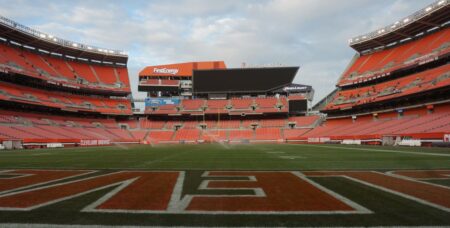Chicago Mayor Lori Lightfoot has reiterated her desire for the Chicago Bears NFL franchise to remain in the city and is open to discussions on the potential improvement of the team’s Soldier Field stadium.
In June, the Bears submitted a bid to purchase Arlington International Racecourse, a move which Lightfoot described at the time as “clearly a negotiating tactic” amid talk over the team’s long-term future at Soldier Field.
The racecourse sits on a 326-acre site around 30 miles northwest of Soldier Field, which is the oldest stadium in the NFL having opened in 1924. With a capacity of 61,500, Soldier Field is also the smallest stadium in the league and Lightfoot has admitted that the venue lags behind its rivals in terms of fan experience and its multi-use offering.
The stadium, which the Bears have called their regular home since 1971, underwent a $690m (£506m/€588m) renovation in 2002. With the Bears’ current lease deal to play at the stadium due to run until 2033, Lightfoot has expressed a desire to keep the Bears in the city beyond then and is urging the team to engage in discussions to improve Soldier Field, which is owned by the Chicago Park District.
In an interview with the Chicago Sun-Times newspaper, Lightfoot said: “I am a Bears fan. I want the Bears to stay in the city of Chicago. And we are willing to work with them to try to address their concerns. But, I’ve got to do it in a way that is fiscally prudent and doesn’t preclude other uses in that stadium.
“We are evaluating ways in which we can enhance the fan experience at Soldier Field … I know that it can be better. I’ve been to other stadiums across the country where the fan experience is far superior to what we have at Soldier Field.”
Lightfoot would not be drawn on whether the addition of a retractable dome to Soldier Field would make it a more suitable year-round venue. The Mayor did however insist that more must be done to ensure the venue is not used solely as an NFL stadium.
She added: “There are other stadiums across the country that I’ve been to that have really taken advantage of the ability to make the stadium a year-round destination – not just something that’s only used during football season and then lays dormant for the rest of the year.
“That stadium sits on a museum campus … Outside of Bears’ season, there’s no real dining experience except for the food within the museums themselves. Even afterward, if you want to enjoy a nice meal or convene in another place, you’ve got to go outside of the stadium footprint.”
Image: Ken Lund/CC BY-SA 2.0/Edited for size





